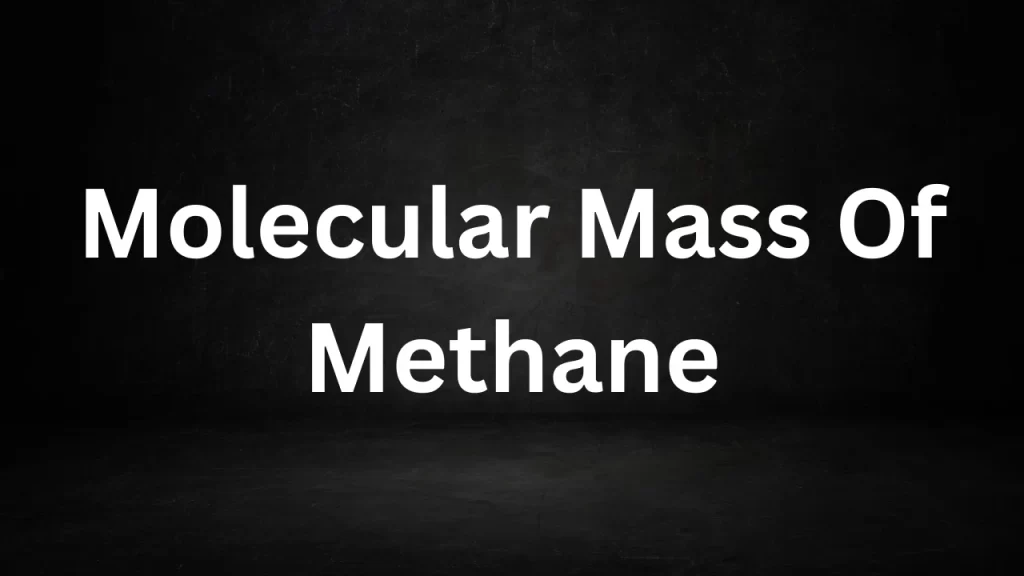Tag: methane molar mass
Molar Mass Of Methane
Molar Mass Of Methane: Methane (CH4) is a simple but crucial compound in the world of chemistry, with diverse applications ranging from energy production to greenhouse gas emissions. To comprehend its properties and behavior, one fundamental concept to explore is its molar mass.

Molar Mass Of Methane
1. What is Molar Mass?
Molar mass is a fundamental concept in chemistry that quantifies the mass of a substance in grams per mole (g/mol). It represents the mass of one mole of molecules or atoms of a chemical compound. Molar mass is expressed in grams per mole (g/mol) and is often denoted as “M.”
2. Why is Molar Mass Important?
Molar mass is crucial in various chemical calculations, including determining the amount of substance in a sample, converting between mass and moles, and understanding the stoichiometry of chemical reactions. It serves as a bridge between the macroscopic world (mass in grams) and the microscopic world (number of atoms or molecules).
3. Calculating the Molar Mass of Methane (CH4):
To calculate the mol mass of methane (CH4), we need to consider the atomic masses of its constituent elements: carbon (C) and hydrogen (H).
- The atomic mass of carbon (C) is approximately 12.01 g/mol.
- The atomic mass of hydrogen (H) is approximately 1.01 g/mol.
To find the mol mass of methane (CH4), we add up the atomic masses of its constituent atoms:
Molar Mass of CH4 = (1 × Molar Mass of C) + (4 × Molar Mass of H)
The Molar Mass of CH4 = (1 × 12.01 g/mol) + (4 × 1.01 g/mol)
Molar Mass of CH4 = 12.01 g/mol + 4.04 g/mol
Molar Mass of CH4 ≈ 16.05 g/mol
So, the mol mass of methane (CH4) is approximately 16.05 grams per mole (g/mol).
4. Significance of Methane’s Molar Mass:
Understanding the mol mass of methane is crucial in various scientific and industrial applications:
- Energy Production: Methane is a significant component of natural gas, making its molar mass vital for calculating the energy content of natural gas used for heating and electricity generation.
- Chemical Reactions: Chemists use molar mass to balance chemical equations, determine reactant and product quantities, and predict reaction outcomes.
- Environmental Impact: In environmental science, the molar mass of methane is relevant when assessing its role as a greenhouse gas. Methane’s molar mass influences its global warming potential.
- Industrial Processes: Molar mass calculations are essential in industrial processes involving methane, such as the production of hydrogen, synthesis of organic compounds, and manufacturing of chemicals.
Conclusion:
The mol mass of methane (CH4) is approximately 16.05 grams per mole (g/mol), which is the combined mass of one mole of carbon and four moles of hydrogen atoms. Understanding the molar mass of methane is essential for various scientific, industrial, and environmental applications, contributing to our knowledge of this versatile compound and its impact on our world.
Read More
- Molecular Mass Of Sodium Hydroxide
- Molar Mass Of Ethyl Alcohol
- Molecular Mass Of Calcium Carbonate
- Molar Mass Of Carbon Dioxide
- Difference Between Force And Momentum
Frequently Asked Questions (FAQs) On Molar Mass Of Methane
1. What is molar mass, and why is it important for methane (CH4)?
Molar mass is the mass of one mole of a substance, expressed in grams per mole (g/mol). For methane (CH4), its mol mass is crucial for various calculations in chemistry, such as determining the amount of substance in a sample and stoichiometry in chemical reactions.
2. How is the molar mass of methane (CH4) calculated?
The mol mass of methane is calculated by adding the atomic masses of its constituent elements: carbon (C) and hydrogen (H). Carbon has an atomic mass of approximately 12.01 g/mol, and hydrogen has an atomic mass of around 1.01 g/mol. Therefore, the mol mass of methane (CH4) is approximately 16.05 g/mol.
3. What is the significance of the molar mass of methane in environmental science?
In environmental science, the mol mass of methane is significant when assessing its role as a greenhouse gas. Methane’s mol mass affects its global warming potential and its contribution to climate change.
4. Why is knowing the molar mass of methane important in the energy industry?
Understanding the mol mass of methane is vital in the energy industry because methane is a major component of natural gas. It helps in calculating the energy content of natural gas, which is essential for heating and electricity generation.
5. How is the molar mass of methane used in chemical reactions?
Chemists use the mol mass of methane to balance chemical equations, determine reactant and product quantities, and predict the outcomes of chemical reactions. It plays a crucial role in stoichiometry, which is essential for chemical analysis and synthesis.
Molecular Mass Of Methane
Molecular Mass Of Methane: Methane, the simplest hydrocarbon, is a vital component in the world of chemistry and energy.
Understanding its mole mass is key to comprehending its significance in various scientific, industrial, and environmental contexts. In this article, we will delve into the molecular mass of methane, its composition, and its relevance in diverse fields.

Molecular Mass Of Methane
The Composition of Methane
Methane, represented as CH4, is a hydrocarbon consisting of one carbon (C) atom bonded to four hydrogen (H) atoms. It is the primary component of natural gas and is widely distributed in Earth’s atmosphere, making it a crucial player in the carbon and energy cycles.
Calculating the Molecular Mass
To calculate the mole mass of methane (CH4), we need to consider the atomic masses of carbon and hydrogen. The atomic mass of carbon (C) is approximately 12.011 atomic mass units (amu), while the atomic mass of hydrogen (H) is approximately 1.00784 amu.
The mole mass (also known as molar mass or molar weight) of methane is determined by summing the atomic masses of its constituent elements:
Molecular Mass of CH4 = Atomic Mass of C + 4 × Atomic Mass of H Molecular Mass of CH4 ≈ 12.011 amu + 4 × 1.00784 amu Molecular Mass of CH4 ≈ 16.043 amu
So, the molecular mass of methane (CH4) is approximately 16.043 atomic mass units (amu) or 16.043 grams per mole (g/mol).
Significance of Methane’s Molecular Mass
- Energy Source: Methane is a valuable energy source and is often used as natural gas for heating, electricity generation, and fueling vehicles. Its mole mass is essential for calculating energy content and combustion efficiency.
- Climate Change: Methane is a potent greenhouse gas. Its mole mass plays a role in climate change discussions, as it affects its residence time in the atmosphere and its impact on global warming.
- Chemical Reactions: Understanding the mole mass of methane is crucial in chemical reactions, such as combustion and methane reforming, which are significant in energy production and chemical processes.
- Environmental Monitoring: Researchers use methane’s molecular mass in environmental studies, including the measurement of methane emissions from natural sources and human activities.
- Industrial Processes: Methane’s mole mass is vital in various industrial applications, such as chemical synthesis, metallurgy, and the production of hydrogen and other chemicals.
Conclusion
Methane, with its mole mass of approximately 16.043 atomic mass units (amu), is a fundamental hydrocarbon with diverse applications and implications. It serves as a vital energy source, a contributor to climate change, and a key participant in chemical reactions and industrial processes. As we continue to explore sustainable energy sources and address environmental concerns, the mole mass of methane remains a critical factor in our scientific and technological endeavors.
Read More
- Molecular Mass Of N2
- Molar Mass Of I
- Molecular Weight Of Cl
- Molecular Mass Of Sodium Carbonate
- Molecular Mass Of Nitric Acid
Frequently Asked Questions (FAQs) On Molecular Mass Of Methane
1. What is methane, and why is its molecular mass important?
Methane (CH4) is the simplest hydrocarbon and a major component of natural gas. Its mole mass is crucial for various scientific, industrial, and environmental applications.
2. How is the molecular mass of methane calculated?
To find methane’s molecular mass, add the atomic weights of its elements: one carbon (C) and four hydrogen (H) atoms.
3. What is the molecular mass of methane (CH4)?
The molecular mass of methane is approximately 16.043 atomic mass units (amu) or 16.043 grams per mole (g/mol).
4. Why is methane considered a significant energy source?
Methane, burned as natural gas for heating, power, and vehicles, relies on its mole mass for energy calculations.
5. How does methane contribute to climate change, and what role does its molecular mass play?
Methane is a potent greenhouse gas that traps heat in the atmosphere. Its molecular mass affects its residence time in the atmosphere and its impact on global warming.
Molecular Mass Of Ch4
Molecular Mass Of Ch4: Methane (CH4) is the simplest hydrocarbon, consisting of one carbon atom bonded to four hydrogen atoms. In this article, we will explore the molecular mass of methane and its significance in chemistry and various applications.
Molecular Mass Of Ch4
The Role of Methane
Methane, often called “natural gas” when it’s in its gaseous state, plays a crucial role in both nature and industry. It is a potent greenhouse gas and a primary component of the Earth’s atmosphere. Methane also serves as a valuable energy resource when extracted and used for heating, electricity generation, and as a fuel for vehicles.
Molecular Structure of Methane
Before we delve into the molecular mass of methane, let’s examine its molecular structure. Methane consists of a single carbon (C) atom bonded to four hydrogen (H) atoms, forming a tetrahedral arrangement. This simple, symmetrical structure is the foundation of the hydrocarbon family and showcases the versatile nature of carbon in forming covalent bonds.
Molecular Mass of Methane (CH4)
The molecular mass of a compound, also known as its molar mass, is defined as the mass of one mole of molecules of that compound, expressed in grams per mole (g/mol). To calculate the molecular mass of methane (CH4), we sum the atomic masses of its constituent atoms:
- Carbon (C) has an atomic mass of approximately 12.01 g/mol.
- Hydrogen (H) has an atomic mass of approximately 1.01 g/mol.
Now, let’s calculate the molecular mass of methane:
Molecular Mass of Methane (CH4) = (1 × Atomic Mass of Carbon) + (4 × Atomic Mass of Hydrogen)
Molecular Mass of Methane (CH4) = (1 × 12.01 g/mol) + (4 × 1.01 g/mol)
Molecular Mass of Methane (CH4) ≈ 16.05 g/mol
So, the molecular mass of methane is approximately 16.05 grams per mole.
Significance of Molecular Mass in Chemistry
The molecular mass of methane is a fundamental value in chemistry. It is used in stoichiometry, chemical calculations, and the formulation of chemical equations. This value helps chemists determine the quantity of methane involved in chemical reactions, allowing for precise measurements and the ability to predict reaction outcomes.
Conclusion
The molecular mass of methane (CH4), approximately 16.05 g/mol, is a crucial piece of information for chemists, scientists, and engineers. It highlights the fundamental nature of this simple hydrocarbon, which not only plays a significant role in our environment but also serves as an essential resource in various industrial and energy applications. Understanding the molecular mass of methane is the first step in appreciating its importance in both the natural world and our technological advancements.
Read More
- Nitric Acid Molar Mass
- Molar Mass of Helium
- Molecular Mass of CH3COOH
- Molecular Weight of kmno4
- Molecular Weight of CaCO3
Frequently Asked Questions (FAQs) Molecular Mass Of Ch4
Q1: What is the molecular mass of CH4 (methane)?
A1: The molecular mass of CH4 (methane) is approximately 16.05 grams per mole (g/mol).
Q2: Why is the molecular mass of methane important in chemistry?
A2: The molecular mass of methane is important because it allows chemists to determine the mass of one mole of methane molecules, which is crucial for stoichiometry, chemical calculations, and the formulation of chemical reactions. It helps in understanding the quantity of methane involved in chemical processes.
Q3: What is the molecular structure of methane?
A3: Methane (CH4) has a tetrahedral molecular structure consisting of one carbon (C) atom bonded to four hydrogen (H) atoms. This simple and symmetrical structure is a fundamental representation of hydrocarbons.
Q4: Is methane a natural gas, and how is it used in industry and daily life?
A4: Yes, methane is often referred to as natural gas when it occurs in its gaseous state. It is used for various purposes, including heating homes and buildings, generating electricity, and as a fuel for vehicles. In industry, methane serves as a raw material for the production of chemicals and plastics.
Q5: Is methane a greenhouse gas, and what are its environmental implications?
A5: Yes, methane is a potent greenhouse gas. Its presence in the atmosphere contributes to global warming and climate change. Methane emissions primarily come from natural sources like wetlands and human activities such as the production and transport of fossil fuels, agriculture, and waste management. Reducing methane emissions is a critical step in mitigating climate change.
